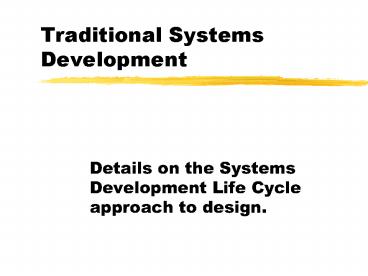Traditional Systems Development - PowerPoint PPT Presentation
Title:
Traditional Systems Development
Description:
How Should we do it? Feasibility Study. Formal report. On user ... Technical: how can we do it? Economic: is it cost justifiable? Legal: are there legal issues? ... – PowerPoint PPT presentation
Number of Views:24
Avg rating:3.0/5.0
Title: Traditional Systems Development
1
Traditional Systems Development
- Details on the Systems Development Life Cycle
approach to design.
2
- Planning
- Priority
- Feasibility
Business
Analysis
Technical
Design
Imple-mentation
Mainten-ance
Operations
3
SDLC Project Management
- Manage development schedule and cost
- Make average contributors more effective
- Prevent genius members from creating a system
that cannot be maintained
4
Initial Investigation
- What is the system supposed to do and what
priority should we give it? - On IS budget
- Memo or oral
- Define users general expectations
- Business justification
- Rough cost
- Assign priority
5
How do we find problems?
- Dictated by business projects
- Competitive initiative
- Surveillance
- Reaction
- Opportunistic
- Frameworks
- Competitive strategy
- Value Chain
6
Initial Investigation
- State the business problem.
- Summarize the proposed IT solution.
- Show how the proposed solution contributes to the
fundamental business goals. - Strategic model
- Estimate net benefits.
7
Response Strategies
- Low Cost Provider
- Differentiation
- Excellence
- Customer Service
- Niche Market
8
Feasibility Study
- How Should we do it?
9
Feasibility Study
- Formal report
- On user budget
- What should we do?
- How should we do it?
- What should it cost?
- How will we use it?
10
Feasibility TELOS
- Technical how can we do it?
- Economic is it cost justifiable?
- Legal are there legal issues?
- Operational does this fit the way we want to do
business? - Schedule can we get it done on time?
11
FormatInclude these sections
- Title page
- Table of contents
- Executive summary
- Problem statement
- Analysis of alternatives
- Cost and benefits
- Recommendation
- Request for authorization
- Appendix
12
Business Decomposition
- What are the business components of the system?
13
Babysitter Service
- The AITP Service Club wants to run a babysitting
service. Customers call to request a sitter and
the Club Coordinator assigns an employee to sit
for the customer from a list of employees
available for the particular day requested.
14
Functional Decomposition
- Determine Employee Availability
- Assign Employees to Job
- Accept Call
- Record Customer
- Record Job
- Assign Employee
- Confirm Assignment
15
Data Decomposition
- Employees
- Customers
- Jobs
16
Function/Data Interaction Matrix
17
Location
- Reach Where should it be available
- Range What functions should it support
- Response How quickly must it respond
18
General Analysis
- Specify logical system requirements
19
TOP DOWN DATA ANALYSIS
- Computer systems are extremely complicated and
cannot be developed without careful planning.
The first step is generally to build a model of
the information system based on the general
objectives and goals it must meet. This is
called top down modeling.
20
E-R Diagram
Employee
Customer
Job
21
Data-Flow Model
- A logical representation of the processes and
data transformation of a system or organization
in graphical form
22
Context Diagram
Request
Customer
Confirirm- ation
Babysitter Information System
Availability
Assignment
Employee
23
Level 1 DFD
Request
Assignment
Availability
Confirirm- ation
1. Assign Employee
2. Offer Availa- bility
Avail Times
New
Current
Avail Times
Job Assign
D1 Customer
D2 Employee
D3 Jobs
24
Communications Model
- A representation of the location at which data is
stored and processed and the communications links
that connect them.
25
General Systems Analysis
- Understand the current system
- Be sure you dont omit essential features
- Obtain detailed specifications of expected
functions - Operations level requirements
- Provide specifications for IT developers to
design from
26
General Analysis
- Is this an information system or a reengineering
project? - Reengineering requires a mandate to change the
way you do business, and requires a major
commitment from all participants. Most
information systems are written to support
existing processes.
27
Detailed Conceptual and Physical Design
- Computer system structure and module specification
28
- Input/Output design
- Logical data structures and views
- Data dictionaries
- System logic definitions
- System flow
- Network design charts
- Documentation
29
System Implementation
- Build it
30
Development
- Structured Code
- CASE tools
- Code generators
- Rapid Application Development
- Object Oriented development
- Prototypes
31
Testing
- Walkthroughs and code inspection
- Application test
- Unit test - each program
- System test - whole system together
- Processes and user acceptance
32
Installation
- Conversion
- Direct
- Phased
- Pilot
- Parallel
- Training
- Operations acceptance
33
Maintenance
- Everything after acceptance
34
(No Transcript)































